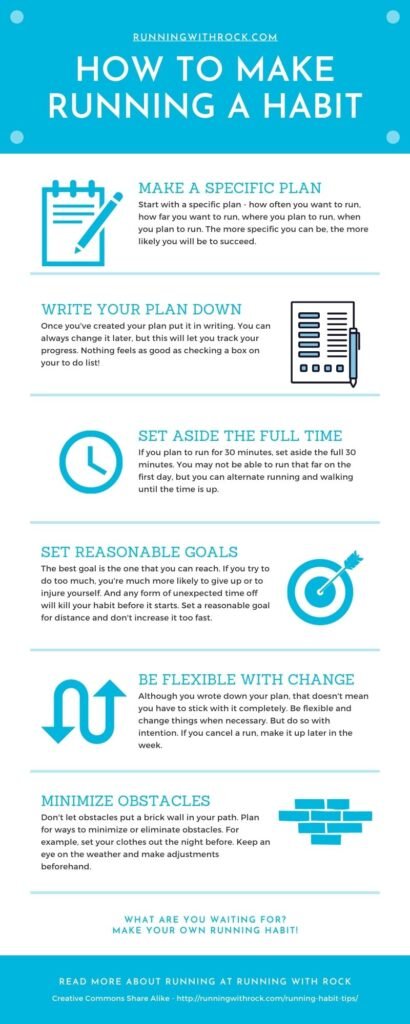Running is hard. At least in the beginning. But once you make running a habit, it gets a lot easier.
If you ask any experienced runner, they’ll tell you that an easy jog is, well easy. I can go out for a few miles on a trail and hardly work up a sweat.
Ask any inexperienced runner, and they’ll tell you that first mile is hell. They can’t breath. They just can’t go on.
The hard part about running is that the only way to get from Point A to Point B is to run – consistently. There are no real shortcuts. So if you want to be able to run and have it feel good, you’re going to have to find a way to make running a habit. Once you establish that consistency, things will get better quickly.
To help with that, here are a few tips on how to make running a habit. Whether it’s a new year, a new season, or just a new week, these tips will help you start out on the right foot and keep going for the long haul.
Make a Specific Plan to Make Running a Habit
The first step to making running a routine is to be intentional about your plan.
“I’m going to start running” is not a plan. It’s an idea.
“I’m going to run five times a week, at least thirty minutes a day” is a better plan. It still leaves out some details – which days are you going to run? Where are you going to run? What time are you going to run? But it does give you some specific and measureable goals.
It’s important to note that you don’t have to run every day – or run the same amount every day – to build a running habit. Days off are important for recovery.
But they should be built into your plan from the beginning. As soon as you wake up and say, “I don’t feel like running today. I’ll take a day off to rest,” you’re on your way to eroding and killing your habit.

Write Your Plan Down and Track It
Once you’ve decided on the specifics of your plan, write it down and come up with an effective system to track it.
Maybe you’re old fashioned and you have a desk calendar. Pencil in your running days and your rest days. Every time you finish a day, cross it off. There’s a lot of power in To Do lists.
Personally, I use a Google Sheet to track my plan. I have my target mileage and/or workouts for the week listed. When I put them into the plan, they’re italicized. When I actually run, I un-italicize them. I also make adjustments if my mileage was different from the goal.
One of the advantages to using technology is that you can do this from anywhere. Sometimes, I open the spreadsheet on my phone and update it. Other times, I do it on my laptop. I’m not limited to logging my miles when I’m in front of a physical calendar.
Set Aside the Time, Even If You Don’t Run it All
Ultimately, your goal may be to run three, five, or more miles at a time. Chances are pretty good that on your first run, you won’t be doing that.
You’re going to end up devoting somewhere around 30 to 60 minutes to each run, but it will take you some time to be able to run the entire thing.
Even if you can only run a half mile, set aside the full thirty minutes. Alternate running and walking. Not only does it help you get in more running time, but this way you’ll be used to spending thirty minutes out on the road.
Set Reasonable Goals and Stay Healthy
It’s really hard to keep a habit going when you’re injured and you can’t run. So it might go without saying that an important part of establishing a running habit is to stay healthy.
If you’re just starting out as a runner or getting back into running after years, that means building slowly. If your goal is to run 3 miles a day, five days a week, but you’ve never run before, you’ll want to start with fewer days and less mileage.
Doing too much, too fast is a great way to get injured – and to kill a habit.
If you’re already a runner, but you’re just having trouble with consistency, this might be a little different. For example, you might regularly go for three mile runs, but your actual running schedule just isn’t consistent. Still, keep your goals realistic for your current level of fitness.
Be Flexible and Make Changes With Intention
Just because you’ve written a plan down doesn’t mean you have to follow it to a ‘T’. Life happens, and you need to be flexible. But if you make changes, you have to do so intentionally and keep the plan in mind.
For example, if you eliminate one day – because of bad weather, an unexpected problem, etc – put it in your plan for another day. Take Thursday off and run Friday.
If you foresee a lot of problems and you’ll be unable to swap all of your runs, you might also want to set limits on how many runs you can eliminate. For example, your schedule might include six runs, but you have a minimum of four “must run.” When life happens, you eliminate up to two runs, but never let yourself go below that minimum.

Eliminate or Minimize Obstacles

You should also do everything you can to plan ahead and minimize those potential obstacles.
For example, by running in the morning you eliminate the problem of surprises happening throughout the day and preventing you from running at night. Get it out of the way before you go about the rest of your day.
Finding a convenient place to run is important. I usually step out my door and start running within a quarter mile. If you have to drive to a gym, a track, or a trail, you’ve added another obstacle that can stop you from going.
Having appropriate gear will help you deal with weather. There are times when you should probably stay home (blizzards, hurricanes, severe cold or heat), but generally speaking you can get out there and run in bad weather. Be prepared for rain or cold, so that’s not an obstacle.
Or, if you really can’t get yourself out in the bad weather, get a treadmill to give you an indoor back-up option.
The more you plan ahead, the better off you’ll be. You can’t eliminate every obstacle, but with a little planning you can minimize their impact.
Be Consistent and Make Running a Habit This Month
With these six tips, you can effectively make running a habit this month.
Remember to create a specific plan and write it down. Set aside the time you’ll need to run, and be realistic with yourself about your goals. If you have to make changes, be intentional about them, and do everything in your power to minimize obstacles that will push you off course.
If you can keep consistent for a month or so, you’ll be well on your way to being a better runner – hopefully for many years to come.
